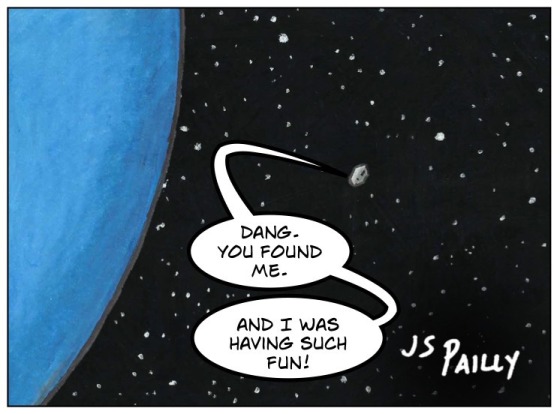Naiad is one of the more rambunctious and troublesome moons in our Solar System. She was first discovered in 1989 when NASA’s Voyager 2 spacecraft flew by Neptune. Naiad then spent more than a decade playing hide and seek with us, to the annoyance of many professional astronomers, I’m sure.

In 2004, the Hubble Space Telescope happened to catch Naiad in a few images of Neptune, but no one noticed she was there. It wasn’t until 2013, thanks to new and improved image processing techniques, that astronomers found Naiad in those pictures.

Articles from the time (like this one or this one) described Naiad’s orbit as “wibbly wobbly” or said Naiad had somehow “drifted off course.” That’s why we’d had such a hard time finding her.
But new research published this month in the journal Icarus gives us a clearer sense of what Naiad’s been up to all this time. Naiad’s orbit is just… I don’t know how to describe it. Just look at this orbit! It’s bizarre!
According to that paper in Icarus, Naiad is caught in an orbital resonance with the neighboring moon of Thalassa. That orbital resonance, combined with a high inclination (orbital tilt), causes Naiad to travel in a “sinusoidal pattern,” as the authors of that paper call it.
Naiad and Thalassa orbit dangerously close to each other. Naiad zips past Thalassa every seven hours, approximately. But because of that weird sinusoidal thing Naiad’s doing, Naiad always passes safely over Thalassa’s north pole or safely under Thalassa’s south pole. The two moons are in no danger of getting into any sort of accident with each other, at least not in the near future.
But there are still a lot of uncertainties baked into our models of Neptune and his family of moons. Even our newest, most up-to-date model—the model that revealed Naiad’s orbital resonance with Thalassa—still depends heavily on data collected by Voyager 2. And as the authors of that Icarus paper note: “The orbital uncertainties show that the positions of the satellites are known within several hundred kilometers until at least 2030.”
But beyond 2030? I guess we can’t accurately predict where Naiad, Thalassa, or any of Neptune’s other moons might end up. If only somebody would send another space probe out to Neptune! I’m really glad we have Voyager 2’s data, of course, but that data is from 1989. A follow up mission is long overdue!

Fascinating! Now I want to know more too
LikeLiked by 1 person
Great! Let’s you and I get a space program together and send a mission out there!
LikeLiked by 1 person
I’m in!
LikeLiked by 1 person
It’s almost like Naiad is halfway in orbit of Thalassa and halfway in its own orbit.
LikeLiked by 1 person
I hadn’t thought of it like that, but I see what you mean. I wonder if this research can be used to better understand whether submoons, or moonmoons, or dwarf moons (or whatever we’re calling them) are possible.
LikeLiked by 1 person
I can’t see why they wouldn’t be possible. Technically weren’t the Apollo command modules moonmoons while they were in orbit of the moon? Maybe a better question is how large can they be relative to the moon they orbit?
LikeLiked by 1 person
Good questions. Naiad and Thalassa have almost the same mass. If Thalassa were significantly larger, maybe it would be possible for her to capture Naiad.
As for the Apollo command modules, would you consider the I.S.S. to be a moon?
LikeLiked by 1 person
Sure. Why not? Or has the IAU issued a definition? 🙂
LikeLiked by 1 person
They have not, which has always seemed really odd to me.
LikeLiked by 1 person